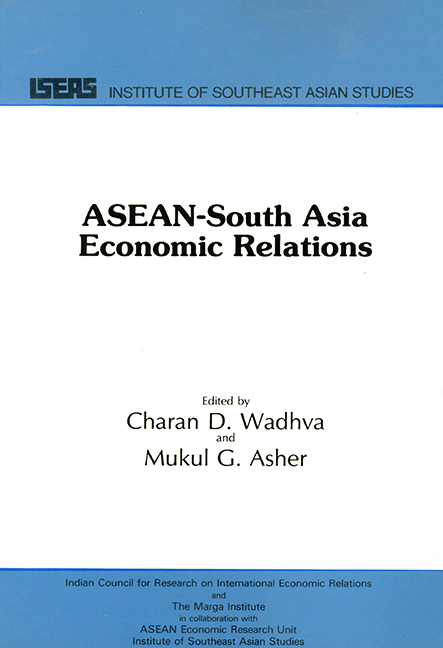Book contents
- Frontmatter
- Contents
- Foreword
- Exchange Rates of ASEAN and South Asian Countries
- An Overview
- PART ONE ASEAN COUNTRY STUDIES
- Economic Relations between Indonesia and South Asia
- Malaysia-South Asia Economic Relations: A Preliminary Study
- Philippine-South Asia Economic Relations
- Economic Relations between Singapore and South Asia
- Economic Relations between Thailand and South Asia
- PART TWO SOUTH ASIA COUNTRY STUDIES
- Postscript
- Appendix SITC Classification at One-, Two-, and Three-digit Levels
- THE EDITORS
Economic Relations between Thailand and South Asia
from PART ONE - ASEAN COUNTRY STUDIES
Published online by Cambridge University Press: 21 October 2015
- Frontmatter
- Contents
- Foreword
- Exchange Rates of ASEAN and South Asian Countries
- An Overview
- PART ONE ASEAN COUNTRY STUDIES
- Economic Relations between Indonesia and South Asia
- Malaysia-South Asia Economic Relations: A Preliminary Study
- Philippine-South Asia Economic Relations
- Economic Relations between Singapore and South Asia
- Economic Relations between Thailand and South Asia
- PART TWO SOUTH ASIA COUNTRY STUDIES
- Postscript
- Appendix SITC Classification at One-, Two-, and Three-digit Levels
- THE EDITORS
Summary
In the light of the recent discussions concerning closer co-operation among developing countries within Asia and the Pacific region, this study attempts to bring out the salient features of existing economic relations between Thailand (a member of the Association of Southeast Asian Nations [ASEAN]) and countries in South Asia. One of the objectives of this survey is to identify ways and means to improve trade, investment, and other economic exchanges between ASEAN in general, and Thailand in particular, and South Asia. Hence, there are four sections in this paper: trade relations; investment relations; other economic relations; and future co-operation.
TRADE RELATIONS
Before the British occupation of the Indian sub-continent in the last century, Thailand was actively trading with countries in South Asia. Some would even suggest that cultural and trade exchanges began in 320 BC in the reign of King Ashok. For our purpose, it suffices to say that trade flows between Thailand and South Asia have been taking place for several decades. In the last decade, the total value of trade between Thailand and South Asia increased from just under US$19 million to US$125 million (see Tables 1 and 2).
Exports of Thailand to South Asia
Exports of Thailand (see Table 1) to countries in South Asia in 1970 stood at US$8.22 million. By 1979, this figure had increased to US$80.79 million. India and Bangladesh were the two largest customers of Thai exports during the period, with Pakistan and SriLanka ranking third and fourth respectively. In terms of goods, the majority of Thai exports to South Asia consisted of food items, mainly rice, to the extent that fluctuations of rice exports changed the whole picture of trade in some years. Exports of raw materials were a distant second to food items, while the share of manufactured exports was less than 1 per cent in 1970 but increased to 25 per cent in 1979.
- Type
- Chapter
- Information
- ASEAN-South Asia Economic Relations , pp. 185 - 222Publisher: ISEAS–Yusof Ishak InstitutePrint publication year: 1985



